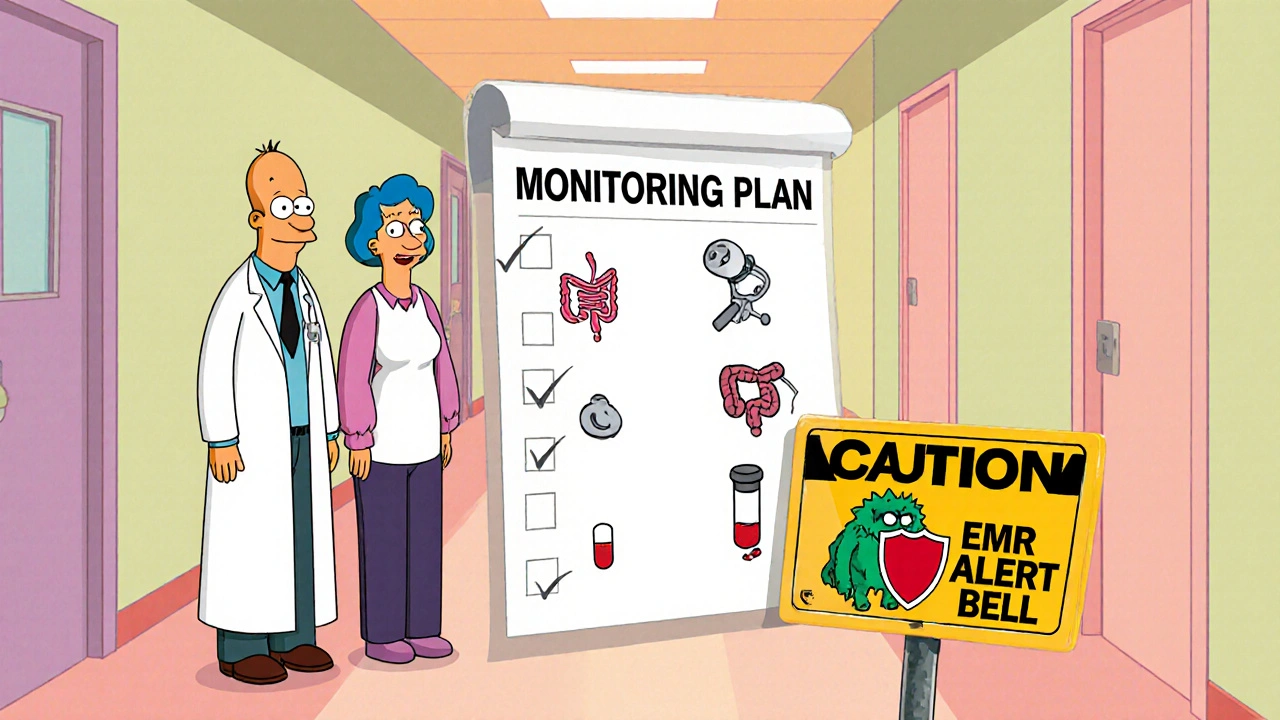Immunosuppressant Recurrence Risk Calculator
Recurrence Rate Comparison
Based on the latest meta-analyses (2016-2024), recurrence rates for various immunosuppressive regimens are shown below. These data indicate no statistically significant increase in cancer recurrence with most immunosuppressants.
Key Takeaways from Evidence
- Current evidence shows no statistically significant increase in cancer recurrence risk for most immunosuppressants
- Historic "wait five years" rule is no longer evidence-based
- Risk should be individualized based on cancer type, stage, and remission interval
- Monitoring should integrate oncology follow-up with disease activity checks
When a patient with rheumatoid arthritis, Crohn’s disease, or psoriasis also carries a history of cancer, doctors face a tricky balancing act. Do you keep the immune system in check with immunosuppressants and risk a flare, or hold back and worry about the cancer coming back? Recent research shows the answer isn’t as black‑and‑white as it once seemed, and today we’ll walk through what the data say, how to keep an eye on recurrence, and what practical steps clinicians and patients can take.
Understanding the Core Players
Immunosuppressants are medicines that intentionally dampen the body’s immune response. They are the backbone of treatment for immune‑mediated diseases such as rheumatoid arthritis, inflammatory bowel disease, and psoriasis. By lowering inflammation, they improve quality of life, but they also blunt the immune system’s natural cancer‑surveillance function.
Another central concept is Cancer recurrence - the return of a previously treated malignancy, either as a repeat of the same tumor or as a new primary cancer that emerges after the original diagnosis. Historically, clinicians worried that any suppression of immunity could let hidden cancer cells grow unchecked.
What the Evidence Says: From 2016 to 2024
The first large‑scale look at this dilemma came from a 2016 systematic review in Gastroenterology. It pooled 16 studies, covering 11,702 patients with prior malignancies who were on various immunosuppressive regimens. The headline numbers were strikingly similar across groups:
- No immunosuppression: 37.5 cases per 1,000 person‑years
- Anti‑TNF therapy: 33.8 cases per 1,000 person‑years
- Traditional immune modulators (methotrexate, azathioprine, etc.): 36.2 cases per 1,000 person‑years
- Combination regimens: 54.5 cases per 1,000 person‑years
All differences had p‑values > 0.1, meaning none were statistically significant.
A follow‑up meta‑analysis published in 2024 expanded the dataset to over 24,000 patients and 85,000 person‑years. It reinforced the earlier message and added newer biologics (ustekinumab, vedolizumab, JAK inhibitors) into the mix. Even when researchers split the data by early (<5 years) vs. late (>5 years) restart of therapy, no impact on recurrence emerged (p = 0.43).
Drug Classes at a Glance
Let’s break down the main drug families you’ll encounter, starting with the ones most often mentioned in the studies.
Anti‑TNF agents block tumor necrosis factor‑α, a key driver of inflammation. Common agents include infliximab, adalimumab, and etanercept.
Methotrexate is a cornerstone conventional immunomodulator used for rheumatoid arthritis and some IBD cases.
Ustekinumab targets interleukins‑12 and ‑23, offering a newer biologic option for Crohn’s disease and psoriasis.
JAK inhibitors (e.g., tofacitinib, baricitinib) act downstream of many cytokine pathways and have entered the therapeutic arena for both rheumatoid arthritis and ulcerative colitis.
| Regimen | Number of Patients | Recurrence Rate | Statistical Significance |
|---|---|---|---|
| No immunosuppression | 3,200 | 37.5 | Reference |
| Anti‑TNF monotherapy | 5,800 | 33.8 | P > 0.1 |
| Conventional IMM (methotrexate, azathioprine, 6‑MP) | 4,600 | 36.2 | P > 0.1 |
| Combination (Anti‑TNF + IMM) | 1,500 | 54.5 | P > 0.1 |
| Newer biologics (ustekinumab, vedolizumab) & JAK inhibitors | 8,200 | 31.2 (numerically lower) | P > 0.1 |

Timing Matters-But Not the Way We Thought
For years, guidelines suggested waiting at least five years after cancer remission before restarting any immunosuppressant. The meta‑analyses overturned that blanket rule. Whether therapy began <6 years or >6 years after the index cancer, recurrence rates stayed flat.
That doesn’t mean timing is irrelevant; it simply isn’t the sole driver of risk. The type of prior cancer, its stage, and the patient’s overall prognosis weigh in heavily.
Putting Monitoring into Practice
Even with reassuring data, vigilant follow‑up remains essential. Here’s a step‑by‑step checklist clinicians can embed into their workflow.
- Baseline review: Collect detailed cancer history-type, stage, treatment, and date of remission.
- Risk stratify: Use an individualized matrix that scores cancer aggressiveness, time since remission, and the immunosuppressant’s mechanism.
- Shared decision‑making: Discuss the evidence with the patient, highlighting that current data show no increased recurrence risk for most agents.
- Surveillance plan: Align cancer‑specific follow‑up (e.g., CT scans, colonoscopy) with routine disease monitoring (e.g., CRP, endoscopy for IBD).
- Electronic alerts: Set EMR reminders for imaging or lab tests at intervals recommended by oncology societies.
- Re‑evaluate therapy: If the patient shows disease flare or new cancer‑related symptoms, revisit the regimen promptly.
Patient stories illustrate the impact. One 58‑year‑old with ulcerative colitis and a prior breast cancer waited four years before restarting infliximab. She experienced a severe colitis flare that required hospitalization. After discussing the latest meta‑analyses, she and her gastroenterologist resumed infliximab at 4.5 years post‑cancer, and she achieved remission without any sign of cancer return over the next three years.
Special Populations: When Caution Still Applies
Even broad data have limits. Certain cancers-especially melanoma, Hodgkin lymphoma, and recent hematologic malignancies-still raise red flags. The European League Against Rheumatism (EULAR) 2023 guidance suggests:
- Delay immunosuppression for at least 12 months after curative treatment for high‑risk melanoma.
- Avoid JAK inhibitors in patients with a history of lymphoma unless benefits clearly outweigh risks.
- Consider non‑immunosuppressive options (e.g., physiotherapy for mild rheumatoid arthritis) when the cancer risk profile is uncertain.
These nuances underscore that a one‑size‑fits‑all rule never works; clinicians must tailor decisions to each cancer‑disease combo.

Emerging Research and What’s Next
Two prospective cohorts are already shaping the next wave of evidence:
RECOVER study (NCT04567821) follows IBD patients with prior malignancy across the United States. Preliminary trends suggest similar recurrence rates across anti‑TNF, ustekinumab, and JAK inhibitor groups, with ongoing data expected in 2026.
RHEUM‑CARE study (NCT04321987) tracks 5,000 rheumatoid arthritis patients with cancer histories. Early analyses indicate that disease control improves quality of life without a measurable rise in new malignancies.
Regulatory bodies have already taken note. The FDA updated labeling for several biologics in 2022, stating that “clinical studies have not shown an increased risk of cancer recurrence in patients with prior malignancy treated with this agent.” Similar language now appears in EMA product summaries.
Key Takeaways for Clinicians and Patients
- Current high‑quality evidence shows no statistically significant increase in cancer recurrence with most immunosuppressants, including newer biologics and JAK inhibitors.
- The historic “wait five years” rule is no longer evidence‑based; timing should be individualized.
- Risk stratify by cancer type, stage, and remission interval, then apply shared decision‑making.
- Implement a structured monitoring plan that integrates oncology follow‑up with disease‑activity checks.
- Remain cautious with high‑risk cancers (melanoma, hematologic malignancies) and consider alternative therapies when appropriate.
Frequently Asked Questions
Can I restart anti‑TNF therapy soon after finishing cancer treatment?
Yes, recent meta‑analyses indicate that starting anti‑TNF agents less than five years after remission does not raise recurrence risk. Decisions should still consider the specific cancer type, stage, and patient preference.
Are newer biologics like ustekinumab safer than classic immunomodulators?
The data show a numerically lower recurrence rate with ustekinumab and other newer agents, but the difference isn’t statistically significant. Safety appears comparable, so choice depends on disease efficacy and patient factors.
What monitoring schedule should I follow?
Combine the oncology follow‑up schedule (e.g., imaging every 6-12 months for solid tumors) with routine disease monitoring (labs, endoscopy, or joint exams). Set EMR alerts to ensure nothing falls through the cracks.
Should patients with a history of melanoma avoid JAK inhibitors?
EULAR recommends a cautious approach: delay JAK inhibitors for at least 12 months after curative melanoma treatment and consider alternatives if the risk remains high.
How reliable are the meta‑analyses given their observational nature?
While they aren’t randomized trials, the pooled sample sizes (>24,000 patients) and consistent findings across multiple disease groups lend strong confidence. Ongoing prospective cohorts will further validate these conclusions.


Comments (7)
Corrine Johnson
24 Oct, 2025The paradox of dampening the immune system while chasing remission lies in the very definition of balance, a balance that modern meta‑analyses suggest is less treacherous than the dogma of yesteryear; researchers have shown that anti‑TNF agents, methotrexate, and even the newest JAK inhibitors do not statistically incite cancer recurrence, a fact that should reverberate through every clinic wall, every conference hall, every patient‑physician dialogue. Yet the echo of fear persists, reverberating like a mantra passed down from an era when observational data were scarce and caution ruled supreme; it is here that the philosopher in us must ask: why cling to a five‑year embargo when the numbers whisper otherwise? The data, spanning over twenty‑four thousand patients, reveal recurrence rates that hover within a narrow band-33.8 to 37.5 cases per 1,000 person‑years-regardless of whether the patient trudges under anti‑TNF monotherapy or embraces a combination regimen, a combination that, though numerically higher, fails to cross the threshold of statistical significance. One must also consider the heterogeneity of malignancies, for melanoma, Hodgkin lymphoma, and recent hematologic cancers still cast shadows that demand bespoke caution; nevertheless, the overarching trend is clear, a trend that challenges the entrenched belief that any immunosuppression is tantamount to inviting malignancy back to the table.
In practice, clinicians should therefore abandon the one‑size‑fits‑all dictum, embracing instead a nuanced, risk‑stratified algorithm that weighs cancer type, stage, and remission interval against disease activity; shared decision‑making becomes not a luxury but a necessity, a dialogue where patients are empowered by evidence rather than shackled by myth. Monitoring protocols must be integrated, aligning oncology imaging schedules with rheumatologic or gastroenterologic assessments, a symphony of surveillance that leaves no gap for rogue cells to proliferate unnoticed. Electronic health record alerts can serve as the ever‑watchful sentinel, nudging providers toward timely labs and scans, thereby transforming vigilance from a burdensome chore into a seamless part of care.
Finally, let us not overlook the human dimension: the patient who endured a severe flare while awaiting the imagined safety of a five‑year pause; her story, now illuminated by data, underscores that delaying effective therapy can cost quality of life, a cost that may outweigh speculative oncologic risk. In sum, the modern narrative demands that we replace fear with facts, dogma with data, and inertia with informed action; only then can we truly honor both the battle against inflammation and the battle against cancer, side by side.
the sagar
3 Nov, 2025Wake up-pharma and the global lobby hide the truth about immune drugs and cancer!
Grace Silver
13 Nov, 2025Balancing immune suppression with cancer vigilance is not a binary choice; it is a nuanced discussion that benefits from both data and compassion. The recent meta‑analyses provide a reassuring backdrop, showing no significant uptick in recurrence across most agents. Yet each patient’s cancer history carries its own narrative, and clinicians must honor that individuality. Shared decision‑making, as highlighted in the article, transforms abstract statistics into concrete reassurance for the person in the exam room. By integrating oncology follow‑up with routine disease monitoring, we create a safety net that feels less like surveillance and more like partnership. Ultimately, the goal is to keep inflammation at bay without compromising the hard‑won remission from cancer. Let’s keep the conversation open and evidence‑driven.
Clinton Papenfus
23 Nov, 2025In accordance with established clinical guidelines, it is advisable to implement a structured monitoring schedule that aligns oncologic imaging intervals with rheumatologic or gastroenterologic assessments. This approach ensures continuity of care while minimizing redundancies. Moreover, employing electronic health record alerts can augment adherence to surveillance protocols, thereby fostering optimal patient outcomes. Let us strive for excellence in practice through disciplined coordination and unwavering commitment to patient safety.
Deborah Galloway
4 Dec, 2025Reading about patients who faced severe flares while waiting for the “right” time to restart therapy really hit home for me. It’s tough to watch someone suffer from their original disease because of fear about recurrence. I’m glad the data show we don’t have to choose between quality of life and cancer risk for most people. If you’re navigating this dilemma, know that you’re not alone and that many clinicians are listening and ready to support you through shared decision‑making. Stay hopeful and keep the conversation open with your care team.
Max Lilleyman
14 Dec, 2025Honestly, the data speak louder than any anecdotal fear-most immunosuppressants aren’t the villains they’re painted as. 🙄💊 It’s time to stop letting outdated myths dictate treatment plans. Let’s trust the research and move forward. 👍
Jonah O
24 Dec, 2025They dont tell u that the big pharmas are pulling strings behind the scenes, makin up studys to keep ur dollars flowin. Everytime a new drug hits the market theres a hidden agenda, its all about control not cure. Dont be fooled by the glossy press releases, keep ur eyes open.